Click on images to enlarge
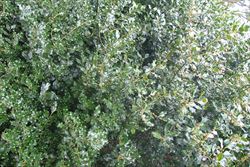
infestation (Photo: Sheldon Navie)

habit of younger tree (Photo: Sheldon Navie)
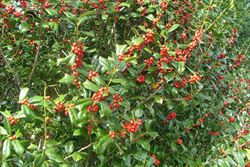
habit in fruit (Photo: Sheldon Navie)
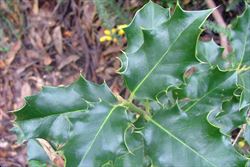
glossy dark green leaves (Photo: Sheldon Navie)

close-up of stem and prickly leaves (Photo: Sheldon Navie)
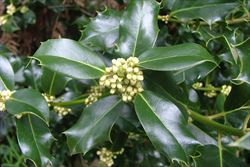
flower buds (Photo: Sheldon Navie)

male flowers (Photo: Greg Jordan)
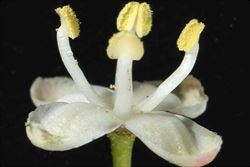
close-up of male flower (Photo: Greg Jordan)

close-up of mature fruit (Photo: Sheldon Navie)

close-up of seeds (Photo: Steve Hurst at USDA PLANTS Database)
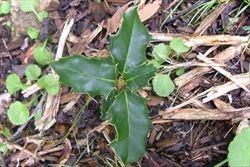
seedling (Photo: Sheldon Navie)
Scientific Name
Ilex aquifolium L.
Family
Aquifoliaceae
Common Names
common holly, English holly, holly
Origin
Native to northern Africa (i.e. Algeria, Morocco and Tunisia), western and southern Europe (i.e. the UK, France, Portugal, Spain, Albania, Bulgaria, Italy and Yugoslavia) and western Asia (i.e. Iran, Syria and Turkey).
Cultivation
Widely cultivated as a garden ornamental and hedging plant in the temperate regions of Australia. Numerous cultivars are available, including some without prickly leaves and others with variegated leaves.
Naturalised Distribution
Widely naturalised in south-eastern Australia (i.e. on the central and southern tablelands of New South Wales, Victoria, Tasmania and south-eastern South Australia).
Also naturalised overseas in New Zealand, western USA (i.e. California, Oregon and Washington) and Hawaii.
Habitat
A weed of forests, forest margins, riparian areas, disturbed sites, waste areas and gardens in the cooler temperate regions of Australia.
Habit
An upright (i.e. erect) shrub or small tree usually growing up to 10 m tall, or occasionally a larger tree up to 15 m in height.
Distinguishing Features
- an upright shrub or small tree usually growing less than 10 m tall.
- its thick and leathery leaves (3-11 cm long and 2.5-5 cm wide) have usually have 5-9 large spine-tipped teeth.
- these leaves have dark green and glossy upper surfaces and paler and duller undersides.
- its small flowers (about 8 mm across) are borne large clusters in the leaf forks.
- separate male and female flowers are borne on separate plants.
- the rounded berry-like fruit (7-10 mm across) turn bright red as they mature.
Stems and Leaves
The younger stems are green and covered in fine hairs (i.e. finely pubescent), while older stems quickly become hairless (i.e. glabrous).
The thick and leathery leaves are alternately arranged on the stems and are borne on stalks (i.e. petioles) 5-15 mm long. These leaves (3-11 cm long and 2.5-5 cm wide) are roughly oval (i.e. oblong-elliptic) in shape with wavy (i.e. undulate) margins and pointed tips (i.e. acute apices). They usually also have 5-9 large spine-tipped teeth. However, the leaves on the upper branches of older trees may lack these, and may even have entire and flat margins. Their upper leaf surfaces are dark green and glossy, while their undersides are paler in colour and duller in appearance.
Flowers and Fruit
The small flowers (about 8 mm across) are usually borne in three-flowered clusters (occasionally 1-6 flowers in each cluster), which are densely arranged into larger clusters in the leaf forks (i.e. axils). Separate male and female flowers are borne on separate plants. All flowers are borne on very short stalks (i.e. pedicels) up to 2 mm long. They have four tiny sepals (about 1.5 mm long) and four white or pinkish petals (2-5 mm long). The male flowers have four stamens and a rudimentary ovary, while the female flowers have four partially formed stamens (i.e. staminodes) and an ovary topped with a short style and a globular stigma. Flowering occurs mainly during autumn.
The fruit is berry-like (i.e. it is actually a drupe) and turns from green to bright red in colour as it matures. These rounded (i.e. globose) or egg-shaped (i.e. ovoid) fruit (7-10 mm across) each contain 2-4 seeds. The light brown or yellowish seeds are either smooth or ribbed.
Reproduction and Dispersal
This species reproduces by seed and sometimes also vegetatively by suckering and layering (i.e. damage to roots stimulates suckering and the lower branches may root where they touch the ground).
The fruit are eaten by birds and other animals which disperse the seeds into bushland. They may also be spread in dumped garden waste. Plants can also spread laterally by suckering and layering to form dense thickets.
Environmental Impact
Holly (Ilex aquifolium) is regarded as a significant environmental weed in Victoria and as an environmental weed in South Australia, New South Wales and Tasmania. It is also listed as a priority environmental weed in two Natural Resource Management regions. This species invades damp and wet forest areas, riparian where it out-competes and replaces indigenous species. It dominates the tall shrub layer, forming dense thickets that create deep shade and prevent the growth and regeneration of native species.
Holly (Ilex aquifolium) is probably of greatest concern in Victoria and Tasmania, where it is actively managed by community groups. It is regarded as a serious threat to wet sclerophyll forests and native riparian vegetation in the Gippsland Plain and Strzelecki Ranges bioregions in southern Victoria. It is also prominent on numerous local and regional environmental weed lists in Victoria (e.g. in Knox City, the Shire of Yarra Ranges, Colac Otway Shire, Mitchell Shire, Nillumbik Shire, Hepburn Shire, the Goulburn Broken Catchment, Sherbrooke Forest and the Dandenong Ranges) and Tasmania (i.e. in the Central Highlands region, the Latrobe municipality and the City of Devonport).
Holly (Ilex aquifolium) is also listed as an environmental weed in the wider Sydney and Blue Mountains region, where it is mainly found in the higher parts of the Blue Mountains. Invasion of this exotic species is also a threat to "Robertson Rainforest in the Sydney Basin bioregion", an endangered ecological community in New South Wales. This species is also listed as an environmental weed in the Southern Highlands of New South Wales and is present in Kosciuszko National Park in this region.
In South Australia, holly (Ilex aquifolium ) has a relatively limited distribution in the Southern Lofty Mountains region. It is listed as an invasive garden plant in the Greater Adelaide region and has been recorded in Mount George Conservation Park.
Other Impacts
The fruit of this species are poisonous to humans.
Legislation
Not declared or considered noxious by any state government authorities.
Management
For information on the management of this species see the following resources:
- the Shire of Yarra Ranges Environmental Weed Fact Sheet on this species, which is available online at http://www.yarraranges.vic.gov.au.
- the weeding methods page on the Friends of Sherbrooke Forest website at http://home.vicnet.net.au/~donvrac/index.htm.
Similar Species
Holly (Ilex aquifolium) can be confused with some native plants that have similar leaves, including native holly (Alchornea ilicifolia), holly-leaved lomatia (Lomatia ilicifolia) and holly-leaved pea (Podolobium ilicifolium).
Native holly (Alchornea ilicifolia) is particularly similar, also having similar flowers and immature fruit. However, its fruit become three-lobed and turn brown in colour as they mature. Holly-leaved lomatia (Lomatia ilicifolia) has much larger elongated flower clusters (15-30 cm long) and larger fruit (20-30 mm long) that split open when mature, while holly-leaved pea (Podolobium ilicifolium) has bright yellow pea-shaped flowers and oppositely arranged leaves.

